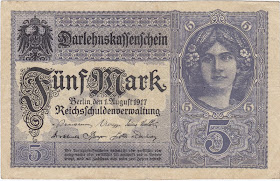First we have the 'Darleh(e)nskassenschein' (without 'e' from 1917 on), notes with lower values.
Secondly, the Imperial Bank Notes (notes issued by the Imperial (National) Bank.
From 1920 on, under the so called Weimar Republic, all notes became 'Reichsbanknoten'.
1914
Two notes were printed.
A 1 Mark and a 2 Mark note. All dated 12 August 1914
KM 50, 51 and 52 are for the 1 Mark
KM 53, 54 and 55 for the 2 Mark note.
The first print (50 and 53) have no underprint colour on the back (just green for the 50, red for the 53).
The notes are printed on white paper.
The second print (51 and 54) have a green or red underprint on the back. there's a brown (51) or red (54) pattern over the entire note. These notes were printed in 1917
Finally the third printing (1920) have blue serial numbers and seals.
 |
| Germany KM 54 front |
 |
| Germany KM 54 back |
1917 -18
In 1917 and 1918 two additional notes were emitted by the Darleh_nskasse, (without 'e').
A 5 and a 20 Mark note came into circulation.
the 5 mark note come with 7 and 8 digits in the serial number.
KM 56a and 56b
 |
| Germany KM 56b - 8 digits in serial number |
 |
| detail KM 56b |
 |
| Germany KM 56b |
 |
| KM 56b detail |
The 20 mark came into circulation in February 1918.
It has 7 digits in the serial number and became KM 57.
 |
| KM 57 |
 |
| KM 57 detail |
 |
| KM 57 |
Can you figger out who are those two beauties at the bottom of the note?
These were the last notes before the 'Weimar Republic' started in 1920.
At the left, Minerva (named after an in Belgian produced car at that time)
At the right, Mercury (easy to recognise with his winged helmet)


No comments:
Post a Comment